Glaciers could become a powerful tool for monitoring some volcanoes, according to new research that shows for the first time how the altitude of glaciers located on volcanoes could signal future unrest including the threat of an eruption.
Monitoring volcanoes is dangerous, expensive, and logistically challenging. Around 250 volcanoes worldwide are covered by glaciers, which present an extra challenge when it comes to monitoring.
But scientists have now shown how glaciers can provide important clues on the behaviour of volcanoes, by sensing their temperature.
A team led by academics from the University of Aberdeen’s School of Geosciences studied 600 glaciers in South America and showed that glaciers located on volcanoes are confined to higher altitudes, while those around the volcanoes reach lower altitudes.
This happens because the increased temperature experienced on or near a volcano causes more ice to melt, limiting glaciers to higher altitudes.
Prior to a period of unrest the temperature of a volcano often increases and by establishing a link between volcanoes and glaciers sitting on them, scientists can now tell which volcanoes have a higher temperature and might be more likely to erupt, and so prioritise monitoring. It could even be used when other monitoring techniques are not possible.
Professors Matteo Spagnolo and Brice Rea from the University’s School of Geosciences led the research, along with colleagues from other universities. Their findings have been published in the journal Geology . The research was funded by the Leverhulme Trust and Natural Environment Research Council (NERC).
Professor Spagnolo said: “Volcanoes are one of the biggest geological hazards on Earth, with more than 500 people killed every year and at enormous financial cost which runs into billions of dollars.
“On-the-ground as well as remote sensing techniques play a crucial role in monitoring volcanoes, but there are challenges in monitoring the 16 per cent of Earth’s volcanoes covered by glaciers which are often located in remote areas – not least because the glaciers themselves make access for monitoring difficult.
“Amongst other signs, volcanoes typically increase in temperature five or more years before an eruption takes place. Our research is the first time a quantitative relationship has been established between glacier elevation and volcanic temperature over a large area, which creates exciting possibilities for monitoring.”
Professor Rea added: “By establishing a link between volcano temperature and glacier elevation, we can analyse glaciers to identify volcanoes which have a higher temperature and might erupt in the near future, and thus the ones on which additional remote sensing and ground monitoring efforts could be directed and prioritised.
“This technique could be used to complement existing monitoring efforts, or may be the preferred option where other monitoring techniques are not possible.”


